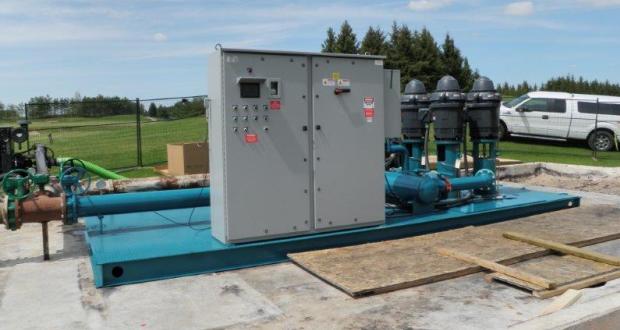The Pros and Cons of Pump Station Replacement

By Dan Gregg
Pump stations are vital to the working operations of any golf course or large landscape property. Even with proper maintenance, there will come a time when the pump station will need to be replaced due to worn-out parts, component obsolescence, or, more commonly, rust.
Superintendents and operators should be aware of the telltale signs of when replacement is imminent. Thanks to new developments and features, today’s pump stations offer superior levels of energy efficiency, pressure and water management, and program customization with the irrigation central controls.
Wear and tear
Preventative maintenance measures as simple as sanding off rust and repainting components will extend the pump station’s life. Other steps — such as monitoring pump motor oil levels, adjusting leaky packing, checking pump performance, lubricating valve handles that may have rusted in place, checking for frayed wiring and cleaning filter screens — can help extend a pump station’s life, but eventually nature will take its toll on an older unit. Newer units will be more energy efficient and more cost effective to operate, but nothing is more valuable than performing quarterly or bi-annual preventative maintenance inspections.
Pump stations are sometimes located in harsh environments, which means they are susceptible to extreme conditions. Water, no matter the source, will lead to rusting of the pump station’s metal structure. Sometimes this only affects the physical appearance of the unit, but other times the rust will eventually crumble the supporting structure — leading to full replacement.
Water with high sodium or chloride can contribute to how quickly a station will deteriorate. Also, water with heavy concentrations of particulates will wear down the pump impellers leading to a shortened service life.
To combat rust, manufacturers have started offering aluminum, special-quality vinyl coatings, and even stainless-steel options for pump stations, as well as specialized coatings on the inside surface of the piping to help lessen the effects of corrosive elements in some water sources. Stainless steel is used on pump stations where harsh weather conditions and salt impact the unit.
The life cycle of a pump station is approximately 20 to 25 years, but in areas where it is working year-round, such as Arizona, the lifespan is usually shorter. In most areas, the unit will run seven to 10 months of the year.
Other signs of replacement include water leaking through weakened connections, distortion of exterior motor components or housing, degradation in pumping efficiency or flow, and units that employ dated technology. With industry advancements in water management and energy efficiency, older motors are not in line with the efficiency standards of newer premium efficient models. Sometimes it can be possible to retrofit units with new pumps and motors, as well as upgrade the control panel, but many times there are compatibility issues making full replacement the only option.
Technology
During the past 30 years, irrigation and pump technology has improved considerably, with the biggest advancements in controls.
Irrigation controllers such as aging electro-mechanical were engineered with no program flexibility, but newer digital units are highly customizable to meet any variety of water needs making them adaptable to local water conservation guidelines and personalized landscape designs. This customization ensures that each micro-climate remains watered to optimal levels, while conserving where possible. More advanced systems even use satellite weather data to provide the user with daily evapotranspiration values to better manage water use.
New pump software programs manage power and efficiency better than ever before with the use of variable frequency drives (VFD). VFD technology enables the control of the AC motor speed and torque by varying the input frequency and voltage to match the system demands. As demand increases, the VFD speeds up, which improves control efficiency and optimizes flow. These pump software programs and better integration with irrigation controls can make today’s pump stations up to 30 percent more efficient than those from 20 years ago.
Replacement
If a station is in need of replacement, the best time to schedule it is when the unit is not in high demand, usually the winter. Even if the pump station needs to be replaced during the summer months, superintendents or operators will seek other options to avoid downtime on their courses. Often, superintendents or operators will work with their pump service providers on a short-term fix until the end of the season. It typically takes two to three days to remove an old station and install the new one. A welder, electrician and pump service technician will need to be onsite to ensure proper fit and operation.
The technological advantages of today’s pump stations make replacement a good option for many courses or properties with aging units. Assess the units to weigh the cost of upgrading against the cost of a repair and maintenance of the current station(s). Additionally, updated systems also contribute to increased energy efficiency and result in cost savings. Contact a sales provider to discuss the customizable and programmable options that are available.
Dan Gregg is the central regional sales manager for Flowtronex Prepackaged Pump Stations, a Xylem Applied Water Systems brand. He is a registered landscape architect, Texas Licensed Irrigator and EPA Water Sense partner with more than 35 years of experience in landscape irrigation design, consultation and sales.



